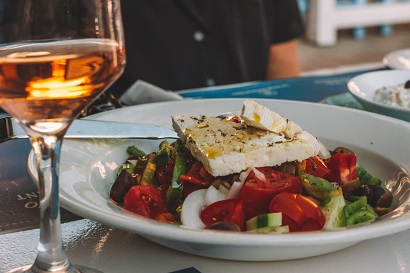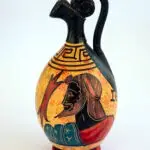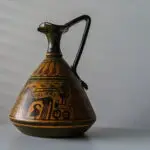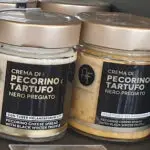When searching for a Greek restaurant on a leisurely weekend date or urban food, it’s likely you’ve come across other cuisine categories like Mediterranean or Middle Eastern. This may be confusing since Yorgo’s Gyro Shop is clearly Greek while Ali Baba’s Shish Kebob Stop is definitely a Mediterranean restaurant that’s Middle Eastern, for example.

But are Greek and Mediterranean food essentially the same? Yes, but they are also different. While Greek food is Mediterranean, not every kind of Mediterranean cuisine is Greek. This is because the Mediterranean is a region of the world and Greece is one part of it.
What compounds the confusion is how many dishes span Greek cuisine with Greek food being at the center of the notorious Mediterranean diet.
What Is Considered Mediterranean Food?
Mediterranean cuisine is from any country encompassing the region surrounding the Mediterranean Sea. This starts at the Rock of Gibraltar, between Morocco and the tip of Spain, and extends east to the Levant. Other Mediterranean countries include:
- Spain
- Greece
- Italy
- Sicily
- Malta
- Algeria
- Turkey
- France
- Lebanon
- Armenia
- Israel
- Egypt
- Syria
- Libya
- Tunisia
- Morocco
Defining Mediterranean Cuisine
Since olive trees splay throughout the Mediterranean, you’ll see Greek dishes and Mediterranean cuisine incorporate a diverse array of olives, garlic, lamb, lentils, lemon, and chickpeas.
Indeed, no table would be complete without hummus, an earthy type of bean dip, fresh vegetables, and soft bread.
Baklava
The same is true for baklava throughout Mediterranean food. This is a dessert with honey, nuts, and cinnamon wrapped in pastry dough. But the dough preparation, nuts, and other flavorings determine the region of the Mediterranean.
Walnuts, Greek honey, and cinnamon denote Greek cuisine while the addition of ground almonds and orange blossom flavoring indicates Algeria. However, the region around the Black Sea uses only hazelnuts rather than walnuts or almonds whereas Sicily incorporates pistachios.
Pasta Dishes
However, many Mediterranean dishes are similar between Mediterranean countries but they are not the same. For instance, pasta dishes are prevalent throughout Greece but also in southern Italy. While both countries make similar pasta, they are quite different.
To illustrate, in Greece they have a dish called “pastichio” (pronounced pah-st-eech-ee-oh, not pistachio). Hollow, round pasta noodles layer with ground beef, béchamel sauce, tomatoes, garlic, and onions.
Unfortunately, many characterize pastichio as “Greek lasagna.” This couldn’t be further from the truth.
Lasagna has long, flat sheet noodles with cooking agent options like tomato sauce, garlic, olive oil, onions, ground meat, and cheeses like ricotta, mozzarella, and parmesan. So, while both lasagna and pastichio are layered pasta dishes, they have different ingredients.
Is Greek also Mediterranean?
Greek is also Mediterranean. Although only one country in the region, it sits in the heart of the Mediterranean and is the basis for the Mediterranean diet.
These cuisines share many similarities but there are also some marked differences.
Therefore, Greece and Greek food is from the Mediterranean Sea but it does not solely belong to it. This idea extends to the Mediterranean diet. Greek food is the star of the Mediterranean diet, but the Mediterranean diet can also incorporate other famous regional dishes.
What Is Considered Greek Food?
Greek cuisine encompasses several items that characterize its quintessential flavor, texture, and appearance. When most people think of Greek food, they automatically envision things like a Greek salad, gyro with pita bread, souvlakia (meat skewers with vegetables), and other Greek culinary traditions like tzatziki sauce and feta cheese.
While these are traditional Greek cuisine, other delectable dishes lend credence. For instance, lamb is intrinsically synonymous with Greek cuisine along with tapioca pudding, coffee, and baklava. But these are also part of many Mediterranean dishes.
Other Popular Dishes from Greek Cuisine
However, there is other mouthwatering food in Greek cuisine. These give a greater understanding of how the Greek diet organizes flavors, healthy fats, and whole grains that define it as indelibly a Greek diet.
- Moussaka (pronounced moo-sah-kah): A Greek food of national cuisine comprising potatoes and eggplant along with lamb or beef, this is a type of hearty casserole. It comes topped with a light and fluffy béchamel sauce that gets baked until golden brown.
- Spanokopita (pronounced spahn-oh-koh-pita): Filo dough (or puff pastry) wraps around a blend of scallions, feta, eggs, and spinach or other vegetables. Once slathered with olive oil, it goes into the oven until the crust turns puffy and light golden brown.
- Saganaki (pronounced sah-gah-na-key): Some people may know this from local Greek restaurants. It’s flaming cheese drenched in flour, fried, tossed with whisky, and set alight. The cheese can be anything traditional or have a modern twist like asiago, halloumi, or kefalograviera.
- Dolmades (pronounced dole-mah-des): Dolmades are a true delicacy of ancient Greeks, encompassing all that defines it. Fermented or pickled grape leaves wrapped around rice, veggies, and sometimes minced meat with herbs like mint served on small plates.
- Avgolemono (pronounced avgo-leh-meh-no): This is chicken broth comprising egg yolks, orzo rice, shredded chicken, and lemon juice. It’s essentially the Greek version of traditional American chicken soup for when you’re sick or for a quick lunch.
Are Greek and Middle Eastern Food Similar?
Because several Middle Eastern countries share the Mediterranean region with Greece, they have some similar menu features. Yet, they are different cuisines with some similarities being a point of cultural contention.
What’s more, Middle Eastern cuisine has different tastes complete with specialized dishes, flavors, vegetables, and Mediterranean recipes. For instance, almost every Mediterranean restaurant, most Greek restaurants, and household tables have hummus.
This is chickpeas mixed with salt, pepper, olive oil, lemon, and tahini sauce (made from sesame seeds).
But, additional herbs make it specific to Greek or Middle Eastern tastes. For instance, the addition of cumin makes it more Lebanese or Egyptian.
Coffee is another example. Turkey and Greece serve coffee the same way. They use intensely fine ground beans that steep directly in hot water. But both cultures claim this brewing style as their own while Egypt, Yemen, Armenia, and the former Yugoslavia also make it the same way.
- The Top Restaurants Specializing in Truffle Dishes - August 10, 2023
- Truffle Panna Cotta: A Decadent Dessert Recipe for Truffle Lovers - August 7, 2023
- Truffle Scrambled Eggs: A Luxurious Breakfast Delight - August 7, 2023








